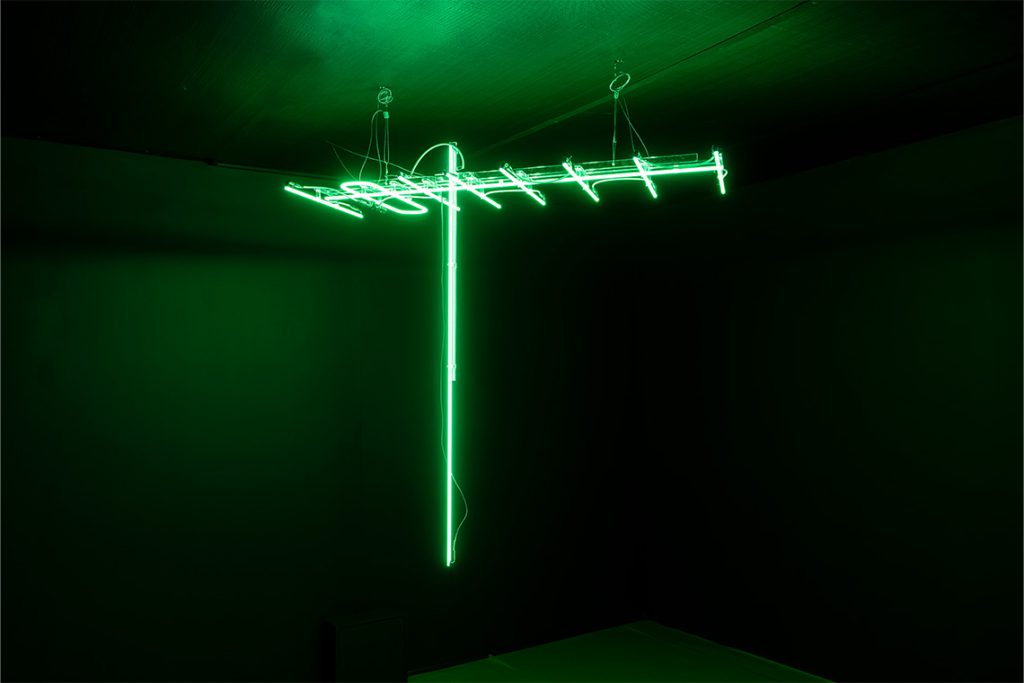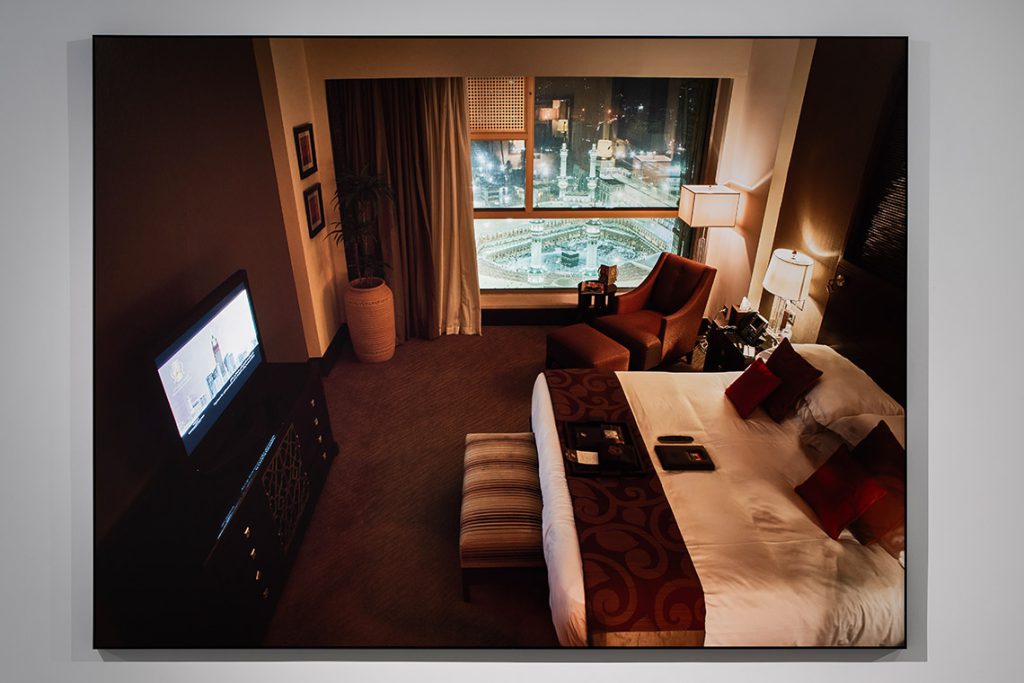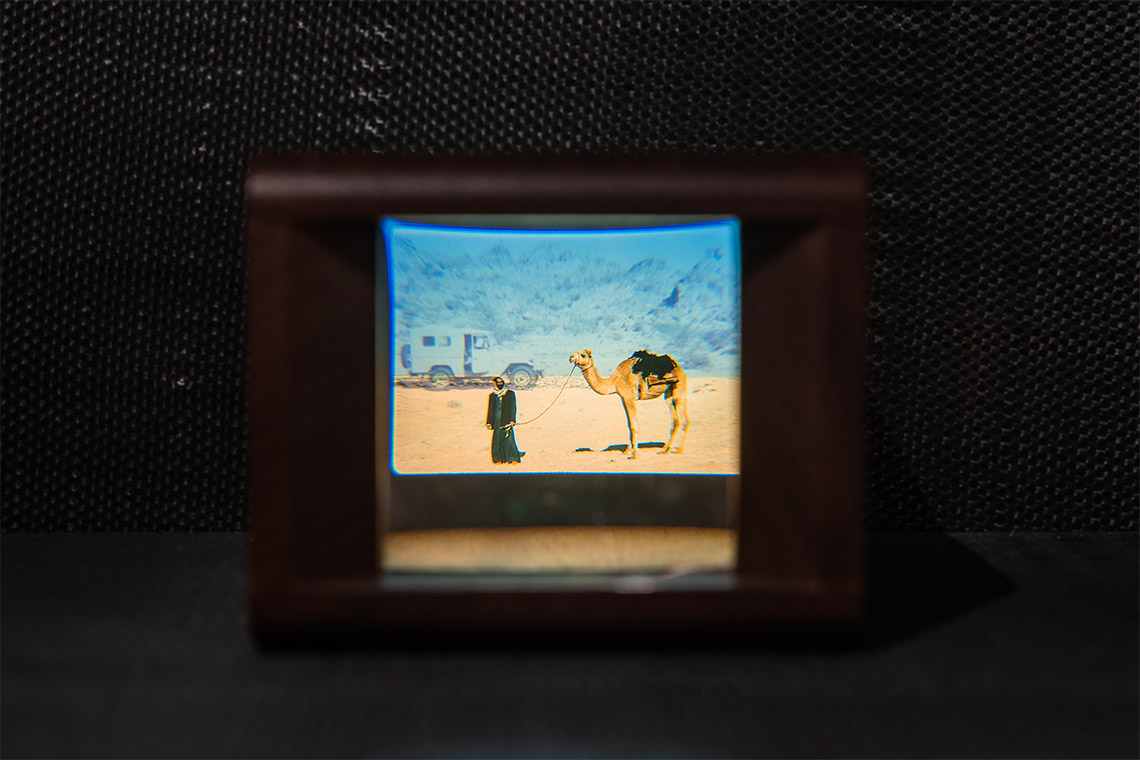In his current exhibition, Antenna at UCCA Edge in Shanghai, Ahmed Mater offers an exploration of memory, displacement and transformation, inviting viewers to tune into the layered signals of a rapidly shifting region.
It begins with a frequency, or perhaps a faint memory. Antenna, Ahmed Mater’s first solo exhibition in China — and the first ever by a Saudi artist at UCCA Edge – functions less as a retrospective and more as a transmission. This is not a presentation in the traditional sense, but a kind of listening device, tuning into overlapping frequencies of memory, displacement, surveillance and transformation. There is a risk to landing an exhibition in a new given context, but Antenna succeeds in presenting a glimpse of Mater’s life experience, providing his perspective so that we can peep into a lost time in a strange and familiar region.
At the entrance to the exhibition space is Boundary (2024), a security scanner that takes the shape of a mihrab, with carved wooden Islamic motifs and equipped with an infrared detector. While it marks one’s arrival at the show, it also responds to the post 9/11 security check protocols that target a certain ethnic group. The prevention and surveillance methods have only intensified since then, reshaping the world in terms of how people travel, whether internationally or simply between two metro stops. Mater’s work here is imbued with visual irony as critical empathy, designed not merely to expose but also to invite reflection and to hold contradiction without resolution. He inverts power by aestheticising the mechanisms of control, and in so doing so destabilises the gaze itself.

Around the corner is Antenna (Green) (2010), a suspended TV antenna made of neon light. Such devices were ubiquitous in the pre-cable TV era, functioning as receivers of TV signals, but they also symbolised a curiosity for the world beyond, with the electromagnetic waves travelling across humanmade borders. Serving as access conduits to news, entertainment and cinema, they required careful positioning in the right direction and with the appropriate angle. The medium and form of Mater’s artwork is simple but effective, recalling cozy memories of a curious childhood and a thirst for the unknown.
In the major room on the first floor is the visually striking Magnetism series (2009, 2012, 2024), which consists of an installation, photography and an opened book. In an obvious visual reference to the Hajj pilgrimage, the artist has replaced the spiritual attraction with a physical one. The swirl indicates the tawaf, the circumambulation by the faithful of the Ka’aba, a tidal rhythm in contrast with the stay-still iron powder, the black against the white, the circle against the cube, rational against irrational.
Mater has applied dichotomy in this duochromatic work. A growing population has made the Hajj a spectacle, with an important economic role and a decidedly consumerist dimension. This topic recurs in the photographic work Room with a View ($3,000/night) (2012), which depicts a luxurious hotel room with a view of the Ka’aba. While it is normal for hotel prices to rise in response to demand from the tourists and pilgrims pouring into Makkah during the pilgrimage season, USD 3000 per night is definitely beyond the pocket of most visitors. Yet – in a pattern of imbalance and inequality also evident in rapidly transforming religious centres elsewhere in the world – the wealthy privileged are able to gain advantage, as if spirituality could be measured with coins.

Room with a View belongs to the documentation Desert of Pharan (2012–15), a title that reveals Makkah’s origins and a work that seeks to recall the contrast between now and what the city used to be. Here Mater raises the question again, is it necessary to exploit the underclass to achieve the ‘future’? The transition is also showcased by another work, Ashab Al-Lal: Fault Mirage (2016), where stereoscopic slides merge archival found images with translucent overlays to invoke a spectral archaeology of place. The historical character of the found objects interwoven with the new layers creates a story of lost and found, underlining how new technologies and infrastructures interact with the vast land of nature and a people who are lost in the stream of time. The slide viewer devices beckon the nostalgic past to composing an elegy to the lost time.
Mater’s Antenna is not a retrospective – it is a call and recall, a proposition and a question. What happens when personal memory, geopolitical trauma and visual culture intersect in the gallery space? How and whom do we remember? To walk through Antenna is to tune into a signal not entirely of this world, yet deeply grounded in it. It is an exhibition that listens, variously to history, to silence and to the slow pulse of a region transforming under the weight of its own myths. In Mater’s hands, nostalgia becomes not regression, but resistance – a mode of seeing that opens, rather than closes.



